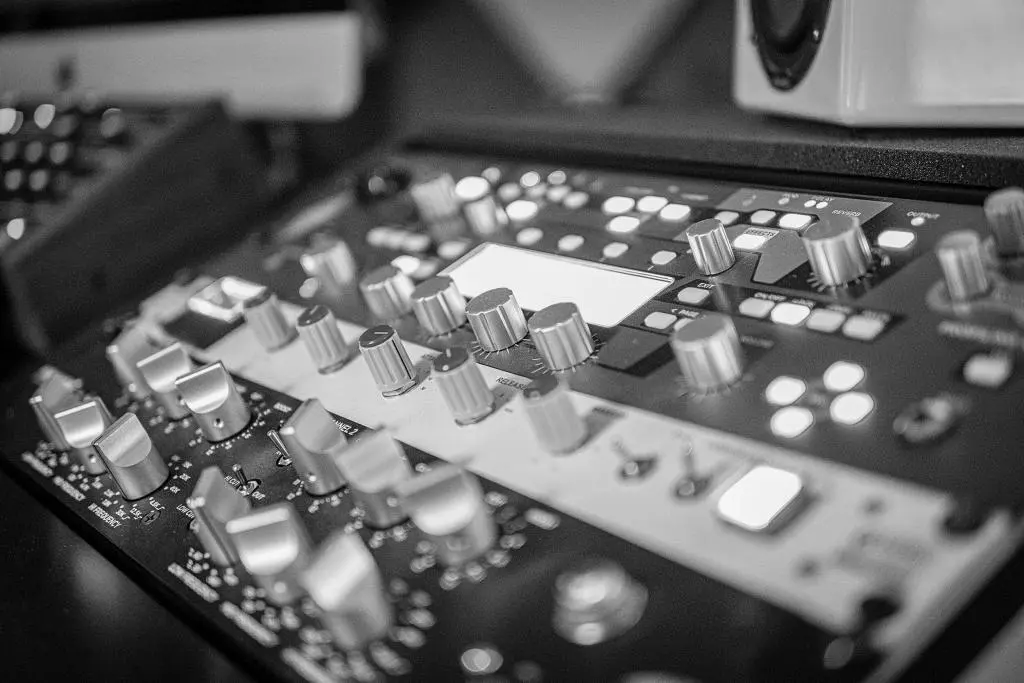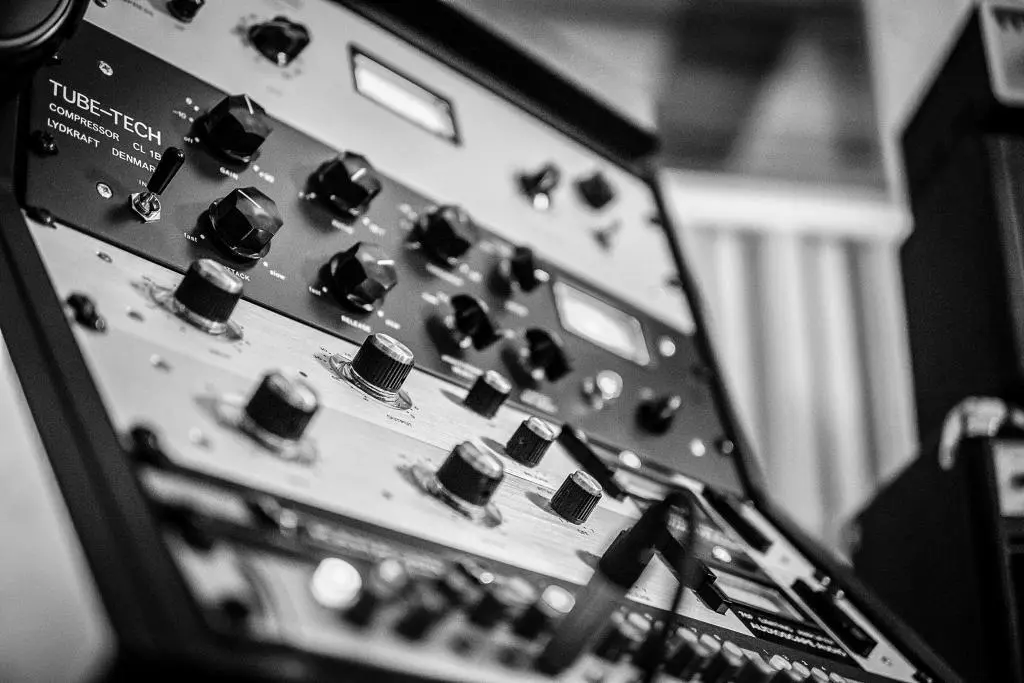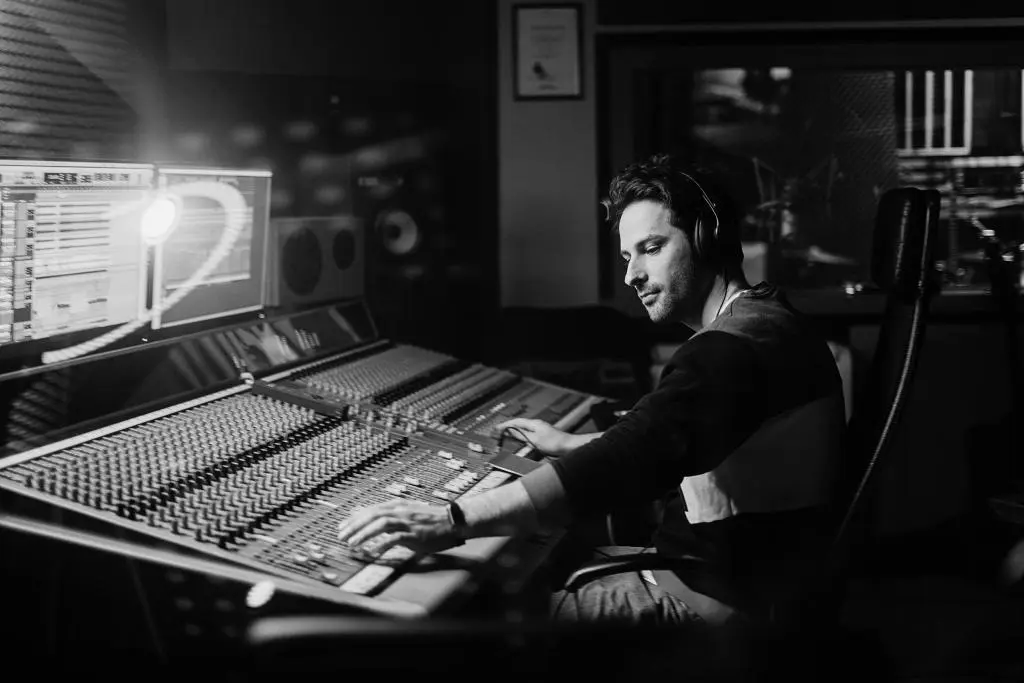Mastering Engineering is the process of optimizing and enhancing the audio quality of a final mix, ensuring it delivers a consistent and superior listening experience across various playback devices, from high-end sound systems to everyday earbuds.

What is Mastering Engineering: Table of Contents
Delving into the Soul of Mastering Engineering
Mastering is more than just a technical endeavor. It’s where artistry meets precision, creating a symphony that resonates with the listener’s soul.
Mastering Engineering Defined and Its Role
At the core of mastering engineering lies the mission to crystallize the sonic essence of a track or an entire album. Masterring engineering acts as the final quality check, ensuring that every beat, note, and subtle nuance is perfectly tuned, ready to enchant listeners across the globe.
The Alchemy of Mastering Engineering
This process has the power to transform. It can take a track that’s merely ‘good’ and elevate it to a level of brilliance. From the raw passion of an indie artist’s first song to the polished perfection of a global chart-topper, mastering is the unseen force that crafts the final auditory masterpiece.

A Nostalgic Journey: Tracing the Evolution of Mastering Engineering
Mastering, often considered the unsung hero of music production, boasts a storied past that mirrors the technological and cultural shifts of the music industry. Its evolution is a testament to the industry’s commitment to delivering the best auditory experience to listeners, regardless of the medium.
From Vinyl to Virtual
The art of mastering engineering began in the early 20th century with the advent of vinyl records. In the 1940s, the introduction of the 33 1/3 RPM long-playing (LP) record by Columbia Records marked a significant milestone. This format required mastering engineers to ensure that the grooves were correctly spaced to accommodate more music on each side. The unique challenges of vinyl, such as the risk of sibilance or the bass causing the needle to skip, demanded a keen ear and specialized techniques.
The 1980s saw the rise of the Compact Disc (CD), a digital format that promised greater fidelity and durability than vinyl. Mastering for CDs required a different approach, focusing on the 16-bit/44.1kHz format, which offered over 74 minutes of music without any physical wear-out mechanism affecting the sound.
Fast forward to the 21st century, and the music world is dominated by digital streaming platforms like Spotify, Apple Music, and Tidal. These platforms introduced the concept of loudness normalization, ensuring tracks play back at a consistent volume, further influencing mastering techniques.
Adapting to the Times
The cassette era of the 1970s and 80s, with its characteristic tape hiss and limited frequency response, presented its own set of challenges. Mastering engineers had to work within these constraints, ensuring that the music still sounded vibrant and full.
The transition to digital in the late 20th century was revolutionary. With the introduction of Digital Audio Workstations (DAWs), mastering engineers had a new suite of tools at their disposal, allowing for precise edits, restoration work, and detailed sonic enhancements.
Today, with the prevalence of high-resolution audio formats and the resurgence of vinyl, mastering engineers juggle the demands of various mediums. They ensure that a track mastered for streaming services, with its strict loudness standards, can also shine on a vinyl record with its wide dynamic range.
Through all these shifts, the essence of mastering remains unchanged: to present music in its best possible light, ensuring that the artist’s vision is conveyed in its purest form to listeners worldwide.

Decoding the Mystique of Mastering Engineering
Mastering, while deeply rooted in technology, is guided by the intuition and passion of the engineer.
Crafting for Every Medium
Mastering is the bridge between creation and consumption. It’s the meticulous process of sculpting a mix to ensure it gleams, whether it’s being played on the nostalgic grooves of a vinyl or streamed in high-definition digital clarity.
The Art and Science of Mastering Engineering
While tools like equalizers, compressors, and limiters are essential, the true magic lies in the hands of the mastering engineer. Their keen ear, combined with a profound understanding of music, refines a mix, bestowing upon it the final touches of brilliance.
Diving Deep: What Exactly is Mastering Engineering?
In the vast realm of music production, mastering engineering stands as a sentinel, ensuring that every piece of audio, every track, and every album reaches its zenith of quality. But what does this process entail? Let’s delve deeper.
Mastering Engineering: The Core Definition
At the heart of music production lies the art of mastering engineering. It’s the final, critical step that ensures an audio recording is primed and perfected for public release.
The Final Touch
Think of mastering engineering as the jeweler who polishes a gem. It’s about taking an audio recording and refining it, ensuring it’s ready to shine brilliantly, irrespective of where and how it’s played. Whether it’s on a high-end stereo system, a car radio, or through a pair of headphones, mastering ensures the audio delivers a consistent and superior experience.
The Mastering Workflow
Mastering isn’t just a single action; it’s a series of meticulous steps, each contributing to the final product’s sonic excellence.
An Overview of the Mastering Process
The journey begins with the mastering engineer receiving the final mix. Using a suite of specialized tools and software, they enhance the audio’s dynamics, balance its frequencies, and ensure it’s optimized for the intended playback format, be it vinyl, CD, or digital streaming.
The Pivotal Position in the Music Production Pipeline
After the raw tracks are recorded and the mix is crafted, mastering engineering steps in as the final guardian. It’s the last checkpoint, the ultimate quality assurance before the world hears the music.
Mastering vs. Mixing: Drawing the Line
While both are integral to music production, mastering and mixing serve distinct roles, each with its unique objectives and techniques.
Distinct Roles and Objectives
Mixing is about balancing individual tracks within a song, ensuring each instrument and vocal shines. Mastering, on the other hand, views the song as a cohesive whole, refining its overall sound.
The Holistic Approach of Mastering
While mixers dive deep into each track, adjusting levels and adding effects, mastering engineers take a bird’s-eye view. Their focus is on the song’s overall sonic landscape, ensuring it’s balanced, clear, and ready for any playback system.
The Versatility of a Mastering Engineer
Mastering engineers are sonic chameleons, adapting their skills to a myriad of projects and mediums.
The Diverse Projects
Beyond albums and singles, mastering engineers work on film scores, TV soundtracks, video game audio, and even audiobooks. Each project, with its unique challenges, requires the mastering engineer’s adaptability and expertise.
Ensuring Sonic Excellence Across Various Mediums
Whether it’s the dynamic range of a vinyl record or the clarity of a digital stream, a mastering engineer ensures that the audio retains its essence, delivering a consistent and high-quality listening experience.

Behind the Console: What Does a Mastering Engineer Do?
In the vast orchestra of music production, the mastering engineer is akin to a conductor, ensuring every note, every instrument, and every nuance harmoniously comes together to create a masterpiece. But what exactly happens behind the closed doors of a mastering studio?
The Technical Symphony
Every song is a unique blend of frequencies, dynamics, and emotions. Mastering engineers, with their suite of tools and trained ears, ensure that this blend is harmoniously balanced and optimized.
The Art of Audio Processing, Sequencing, and Effects
Using tools like equalizers, compressors, and limiters, mastering engineers shape the tone and dynamics of a track. They might subtly boost the bass frequencies for warmth or add a touch of reverb for depth. Sequencing, on the other hand, involves arranging tracks in an album to ensure a fluid listening experience.
Balancing Levels for a Cohesive Audio Experience
One of the primary goals of mastering engineering is to ensure consistency. Whether it’s the volume levels across different tracks of an album or the tonal balance within a single track, mastering engineers ensure that listeners enjoy a seamless and immersive audio journey.
Crafting the Sonic Experience
Beyond the knobs, dials, and waveforms, mastering is deeply intuitive, guided by the soul of the music and the vision of the artist.
Enhancing the Emotional Depth and Message of Music
A song is more than just sound; it’s emotion, story, and message. Mastering engineers tap into this essence, enhancing elements that evoke emotions, be it the melancholy of a ballad or the euphoria of a dance track.
Sculpting the Sonic Landscape for Maximum Impact
Through their expertise, mastering engineers craft a soundscape where every element, from the thumping bass to the delicate vocals, has its own space, clarity, and impact. It’s about ensuring that when a song plays, it doesn’t just sound good; it feels right.
The Final Steps: Preparing for Release
Once the mastering engineer is satisfied with the sonic quality, the track is prepared for its journey into the world.
Encoding, Authoring, and Guiding the Distribution Process
This involves converting the audio into formats suitable for various platforms, be it vinyl, CD, or digital streaming. Metadata, like track names, artist details, and album art, are embedded. The mastering engineer also advises on the best formats and platforms for release, ensuring optimal sound quality for listeners.
Ensuring the Music Reaches Listeners in its Best Form
The final mastered track is a polished gem, and it’s the mastering engineer’s responsibility to ensure it remains so, irrespective of where and how it’s played. Whether it’s being streamed on a smartphone or played on a vintage turntable, the track should deliver the sonic excellence that was crafted in the mastering studio.

The Mastering Engineer’s Toolkit: Skills, Traits, and Knowledge
In the realm of music production, mastering engineers are the unsung heroes, working behind the scenes to ensure that every track resonates with perfection. But what does it take to excel in this intricate field of mastering engineering? Let’s delve into the unique blend of skills, traits, and knowledge that these audio maestros possess.
The Art of Listening
At the heart of mastering engineering lies the ability to listen, not just to hear, but to truly understand the depths of sound.
The Significance of Trained, Critical Listening
While most of us enjoy music, mastering engineers listen with a purpose. They dissect every frequency, identify imperfections, and gauge the emotional impact of a track. Their ears are their most prized tools, trained over years to detect even the slightest anomalies.
Deciphering the Nuances and Subtleties in Audio
In the world of mastering engineering, it’s the details that matter. From the faintest hiss to the subtle reverb tail, mastering engineers have an uncanny ability to pick up on elements that most would miss, ensuring that the final product is flawless.
The Science Behind the Sound
Mastering is as much about understanding the science of sound as it is about the art of music.
Grasping Acoustics, Psychoacoustics, and Audio Processing
A deep understanding of how sound behaves, both in physical spaces and in the human mind, is crucial. Mastering engineers leverage this knowledge to optimize tracks for various playback systems and listener environments.
The Blend of Intuition and Technical Knowledge
While tools and software play a role, it’s the engineer’s intuition, honed over countless hours behind the console, that truly shapes the sound. They know when to trust the waveforms and when to trust their ears.
The Creative Pulse of Mastering Engineering
Beyond the technicalities, mastering is a deeply creative process.
The Balance of Artistic Spirit and Technical Expertise
Every track tells a story, and mastering engineers are the final storytellers. They enhance the narrative, ensuring that the emotional essence of the music is conveyed in its purest form.
Crafting a Sonic Masterpiece with Taste and Precision
It’s not just about making a track louder or brighter; it’s about sculpting a sonic masterpiece. With a keen sense of musical taste and a meticulous approach, mastering engineers breathe life into audio, making it shine.
Beyond the Console: Collaboration and Business Acumen
Mastering doesn’t exist in isolation. It’s a collaborative effort that requires effective communication and a keen business sense.
Effective Communication and Networking in the Industry
Building relationships with artists, producers, and record labels is crucial. Mastering engineers must convey their insights and recommendations while respecting the artistic vision of others.
Navigating the Business Side of Mastering Engineering
In the competitive world of music production, mastering engineers must also wear the hat of entrepreneurs. From marketing their services to understanding the intricacies of contracts, they navigate the business landscape with as much expertise as they do the audio spectrum.
The Journey to Becoming a Mastering Engineer
Embarking on the path to becoming a mastering engineer is a journey of passion, dedication, and continuous learning. From the foundational knowledge to the hands-on experience, every step is crucial in shaping an expert in mastering engineering. Let’s explore the milestones of this fascinating voyage.
Laying the Educational Foundation
Before one can master the art, understanding the basics is paramount.
The Value of Formal Training and Self-Directed Learning
While formal education in audio engineering provides a structured approach to mastering’s intricacies, self-directed learning allows budding engineers to explore at their own pace. Both paths offer valuable insights, whether it’s through classroom lessons or late-night online tutorials.
Exploring the Tools and Techniques of Mastering
Mastering engineering is akin to the fine art of sculpture, where raw audio is meticulously chiseled and polished to perfection. Just as a sculptor employs various tools and techniques to bring a vision to life, a mastering engineer utilizes a diverse array of equipment and methods to craft a sonic masterpiece. Let’s embark on a journey through the intricate landscape of mastering tools and techniques.
- Equalization (EQ): Often considered the paintbrush of sound, EQ allows mastering engineers to boost or cut specific frequency ranges, ensuring that the audio spectrum is balanced. Whether it’s adding warmth to the lows, clarity to the mids, or sparkle to the highs, EQ is the go-to tool for shaping the tonal balance of a track.
- Compression: This technique is all about controlling dynamics. By reducing the difference between the loudest and softest parts of a track, compression ensures a consistent listening experience. It’s not just about making things loud; it’s about preserving the track’s dynamic integrity while ensuring it stands tall next to commercial releases.
- Limiting: The final safeguard in the mastering chain, a limiter ensures that the audio never exceeds a specified output level, preventing distortion and clipping. It’s the last line of defense, ensuring that the mastered track is loud and proud, yet free from any unwanted artifacts.
- Stereo Imaging: The width and depth of a track are crucial for an immersive listening experience. Tools dedicated to stereo imaging allow engineers to adjust the stereo width, ensuring that the track feels expansive without losing focus.
- Harmonic Exciters and Saturators: These tools add subtle harmonics or saturation to the audio, imparting a certain warmth and character. It’s like seasoning in cooking – a little can enhance the flavor, but too much can overpower.
- Reverb and Spatial Effects: Used sparingly in mastering, these tools can add a sense of space or glue disparate elements together. It’s about creating a cohesive sonic environment where every element feels like it belongs.
- Sequencing and Spacing: Mastering isn’t just about individual tracks. When working on an album or EP, the engineer ensures that tracks transition smoothly, with appropriate spacing and sequencing to maintain the intended flow and narrative.
- Metering and Analysis Tools: These are the mastering engineer’s compass and map. From loudness meters to spectral analyzers, these tools provide visual feedback, guiding decisions and ensuring that the audio meets industry standards.
- Dithering: A technical process used when converting between different bit depths, dithering introduces a low-level noise to mask quantization errors, ensuring the highest fidelity during format conversions.
- Format Conversion: Whether it’s preparing a track for vinyl, CD, or digital streaming, mastering engineers ensure that the audio is optimized for each specific format, preserving its quality across diverse playback systems.
In the realm of mastering, tools and techniques are continually evolving, driven by technological advancements and the ever-changing landscape of music consumption. Yet, at its core, mastering remains an art form – a delicate balance of technical prowess and creative intuition. For every tool in the mastering engineer’s toolkit, it’s their ears, experience, and passion that truly shape the final sound.
Gaining Real-World Experience
Theory meets practice in the real world, where true skills are honed.
The Importance of Internships and Mentorships
Stepping into a professional studio as an intern or under the guidance of a seasoned mastering engineer can be transformative. It’s here that one learns the ropes, observes industry best practices, and understands the intricacies of client interactions.
Honing Skills Through Hands-On Practice and Real Projects
There’s no substitute for hands-on experience. Whether it’s mastering a friend’s demo track or taking on freelance projects, every opportunity to practice refines the skills and builds confidence.
Building the Perfect Studio
The environment in which one works plays a pivotal role in the mastering process.
Investing in Top-Tier Equipment and Creating an Optimal Environment
A mastering engineer’s studio is their sanctuary. Investing in high-quality monitors, acoustic treatments, and state-of-the-art audio processors can make a world of difference in the final output.
The Tools That Make a Difference in Mastering
While talent is key, the right tools amplify an engineer’s capabilities. From spectral analyzers to specialized mastering plugins, equipping the studio with the best tools is a testament to one’s commitment to excellence.
Cultivating Relationships in the Industry
In the world of music, relationships are the backbone of success.
Networking and Establishing a Reputation
Attending industry events, joining audio engineering forums, and actively participating in the community helps in building valuable connections. A good reputation, built on trust and quality work, opens doors to bigger opportunities.
The Long Game: Building a Loyal Client Base
Mastering is as much about technical prowess as it is about understanding the artist’s vision. By consistently delivering top-notch work and fostering strong relationships with clients, a mastering engineer can build a loyal clientele that swears by their expertise.
Navigating the Challenges in Mastering
The realm of mastering engineering is not just about sonic perfection; it’s also about navigating a myriad of challenges that come with the territory. From time constraints to managing client expectations and the ever-present loudness wars, mastering engineers face a unique set of hurdles. Let’s delve into these challenges and understand how the best in the business overcome them.
Racing Against Time
In the fast-paced world of music production, time is of the essence.
Meeting Strict Deadlines
Whether it’s an artist eager to release their debut single or a record label with a tight release schedule, mastering engineers often find themselves racing against the clock. Meeting these strict deadlines without compromising on quality is a testament to an engineer’s expertise and efficiency.
Managing Time Effectively
Time management is crucial. By organizing sessions, prioritizing tasks, and employing efficient workflows, mastering engineers ensure that every minute in the studio is productive, leading to timely and exceptional results.
Bridging Client Expectations and Reality
Every artist has a vision, but translating that vision into sonic reality can be challenging.
Tactfully Managing Expectations
Clients often come with high hopes and specific demands. It’s up to the mastering engineer to manage these expectations, guiding clients towards what’s achievable while still aiming for the best possible outcome.
Delivering Results
At the end of the day, results matter. By combining technical prowess, experience, and a deep understanding of music, mastering engineers strive to meet, if not exceed, client expectations, ensuring satisfaction and building lasting relationships.
Overcoming Gear and Studio Limitations
Not every mastering engineer has access to a state-of-the-art studio, but that doesn’t mean they can’t produce top-tier results.
Achieving Professional Results in Varied Studio Setups
Whether working in a home studio or a professional setup, the key lies in understanding the strengths and limitations of the available gear. By leveraging their expertise, mastering engineers can achieve professional results, regardless of their environment.
Adapting and Innovating
The world of mastering engineering is ever-evolving. By staying updated with the latest tools, techniques, and technologies, mastering engineers can overcome gear limitations, ensuring that their output remains top-notch.
The Loudness Wars Dilemma in Mastering Engineering
The music industry has witnessed a relentless pursuit of volume, a phenomenon often referred to as the “loudness wars.” This battle for auditory dominance has seen tracks being pushed to their loudest limits, often at the expense of their dynamic range and overall sonic quality. But what drives this obsession with loudness, and how do mastering engineers navigate this challenging terrain?
The Genesis of the Loudness Wars
The roots of the loudness wars can be traced back to the radio era, where louder songs grabbed listeners’ attention more effectively. As technology evolved, especially with the advent of digital audio, the ability to push volume levels increased. Record labels and artists, eager to make their tracks stand out on playlists and radio broadcasts, began to demand louder masters. The result? A competitive race to the top, where dynamics were often sacrificed for sheer volume.
Striking a Balance Between Loudness and Dynamics
In the midst of this volume frenzy, the role of the mastering engineer became even more critical. Their challenge was twofold: to produce tracks that could hold their own in the loudness battlefield, yet retain the nuances, contrasts, and emotional depth that make music truly impactful. This delicate balancing act requires both technical expertise and a deep respect for the artistry of music. While tools like compressors and limiters can increase loudness, they must be used judiciously to preserve the track’s dynamic range.
The Cost of Overcompression
Overcompression, a common byproduct of the loudness wars, can lead to a flattened sound where quiet and loud moments are indistinguishable. This not only robs the music of its emotional impact but can also lead to listener fatigue. Imagine a world where every sentence is shouted – it’s exhausting and quickly loses its meaning.
Prioritizing Musical Integrity
Mastering engineers are the gatekeepers of sound quality. Their role is not just to satisfy the demands of the industry but to champion the integrity of the music itself. By engaging in open dialogues with artists and producers, they can educate them about the value of dynamics. It’s about making informed choices – understanding that sometimes, less is more. A track with rich dynamics can evoke emotions, tell a story, and create a lasting impact, far beyond the fleeting allure of sheer volume.
The Future of Loudness
With streaming platforms now implementing loudness normalization, the incentive to produce excessively loud tracks is diminishing. This shift offers hope for a future where the art of dynamics is once again celebrated. Mastering engineers, with their unique blend of technical skill and musical sensitivity, will be at the forefront of this renaissance, guiding the industry towards a more balanced and sonically rich future.
The Indispensable Role of Mastering in Music
The world of music is vast, diverse, and ever-evolving. Yet, amidst the myriad of genres, instruments, and production techniques, one element remains consistently crucial: mastering engineering. It’s the unsung hero of the music production process, ensuring that every track, regardless of its origin or style, reaches its listeners in the best possible form. Let’s delve into the indispensable role of mastering in the musical landscape.
From Studio to the World: Preparing for Release
Every song has a journey. It starts as a mere idea, evolves into a composition, gets recorded, and then mixed. But before it reaches the ears of eager listeners worldwide, it undergoes one final, transformative process: mastering.
The Transformational Power of Mastering
Mastering is like the final coat of polish on a newly crafted piece of jewelry. It enhances, refines, and elevates a track, ensuring it’s not just heard, but truly felt by its audience. Through mastering engineering, songs achieve the clarity, depth, and sonic balance that make them radio-ready and universally appealing.
The Quality Assurance in Audio
In the vast sea of music releases, quality is what helps a track stand out, resonate, and be remembered.
Correcting Imperfections and Ensuring Top-Tier Sound Quality
Even the best mixes can have subtle imperfections. Mastering engineering acts as the final quality check, identifying and rectifying these issues. Whether it’s adjusting tonal imbalances, enhancing dynamics, or ensuring consistent volume levels, mastering ensures that listeners get an impeccable audio experience, every time.
The Objective Ear in Music Production
While artists and mix engineers are deeply immersed in the creation process, sometimes, a fresh, external perspective is what’s needed to bring a track to its full potential.
The Value of an External, Expert Perspective in the Production Process
Mastering engineers provide this objective ear. With their vast experience and technical expertise, they can identify areas of improvement that might be overlooked by those too close to the project. Their feedback and adjustments are often the difference between a good track and a great one.
The Final Verdict: Why Every Track Needs Mastering
In today’s digital age, where music is more accessible than ever, the competition is fierce. To truly make a mark, every element of a track needs to be on point, and mastering plays a pivotal role in this.
Appreciating the Behind-the-Scenes Magic of Mastering Engineers
These unsung heroes work tirelessly behind the scenes, adding the final touches that make music shine. Their meticulous adjustments, keen ears, and deep understanding of sound ensure that every song reaches its zenith. In essence, mastering is not just a step in music production; it’s the bridge that connects artists to their audience in the most profound way.

